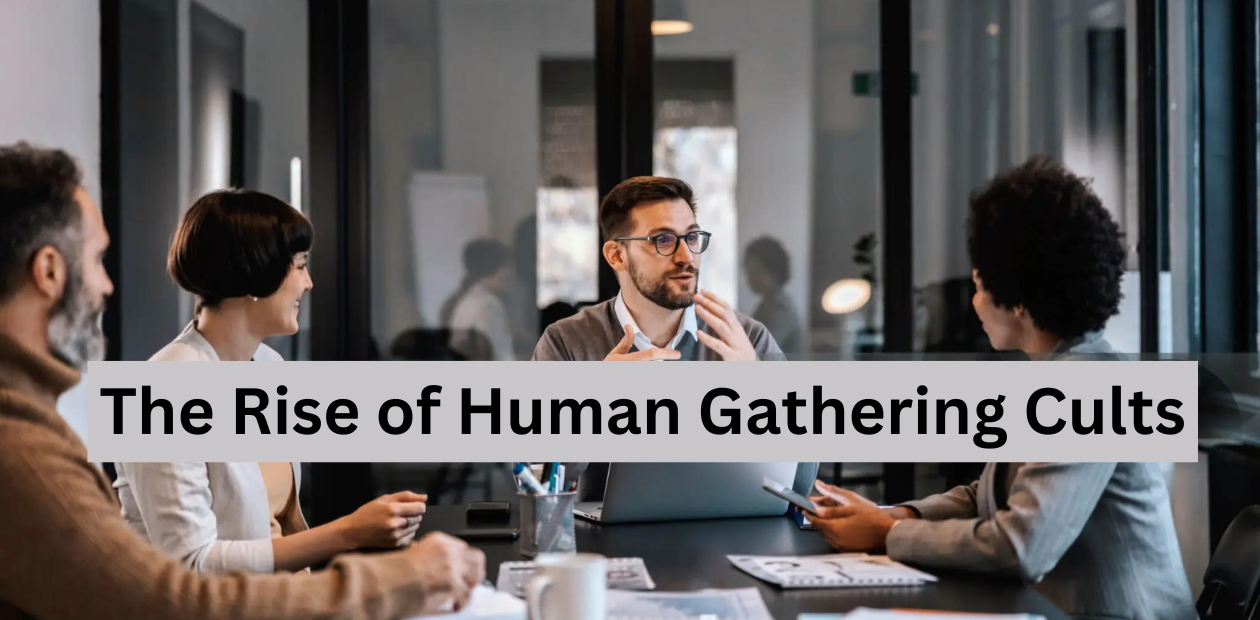Introduction
Recently, the concept of the ‘human gathering cult’ has become quite popular and as a result, people pay much attention to it, possibly due to curiosity. These are cults, which are formed around definite ideas and guided by leaders. people have been attracted and repelled by these groups in equal measure throughout history. But what are the human gathering cults in fact, and what are the reasons for their repeated appearances? In this article the reader will be introduced to the phenomenon of human gathering cults and their description. the theory of their formation, and the psychological effects they cause in people and in society.
Understanding A Human Gathering Cult
Defining the Concept
Conventionally, a human gathering cult is described as a collective of people that is controlled either by a single leader or a dominant set of principles. These groups also expect their followers to be loyal and their beliefs are very enclosed. and do not accept any form of deviation from the set perspective.
Historical background of the human gathering cults
It is important to note that cults are not a phenomenon that can be observed in modern society only. In the course of history different types of human meeting cult distinguished by beliefs and practices and resulting consequences have appeared. In current culture, as in ancient societies, cults—those selective groups of enthusiasts or fanatics devoted to a religion or sacred cause—have been as influential within their individual recruits as they have been disruptive across the cultures in which they are embedded.
Although it is very difficult to point out different cults in attendance to human gathering cults, here are general traits:
The Usefulness of Charisma
Possibly the most important component of a human gathering cult is its leadership. Frequently cult leaders are confident people providing them with the desired ability to dominate their subjects. This is important in enabling the cult to recruit members and also make them committed to the cult.
Pp. 22-32 5 The Family, Ideology and Belief Systems
Most human aggregation cults are inclined around a specific tenet of faith in value. This ideology may in some ways portray a precise dualism of good and evil . where the cult members are the good ‘us’ and the non-members or ‘them’. This kind of dichotomous thinking exposes all the members in a group thereby enhancing or enforcing. the lines that separates the group from the rest of society and explains why the group behaves or holds such a view.
More specifically, this class looks at group dynamics and social influence
In a cult group, other than the leader other factors that help in the exercise of authority are important in the group. Social pressure, group pressure and the obsession of confirmability makes the members. Adhere to the standards and demands of the group even if those are pathological. Through fear of being punished or ostracise, members conform to the set norms hence no rebellion is encourage.
Why People Join Cults: A Look at the Psychological Aspects
The Appeal of Belonging
The need for inclusion is at the heart of many human gathering cults. And this is why the atmosphere of togetherness that such groups provide is so attractive for many people. It can be a powerful and fulfilling thing for people, offering them a role or a raison d’etre that is missing elsewhere.

Psychological Manipulation Techniques
Different cults learn to use psychological pressure in order to dominate their followers. This can entail social seclusion from the outside world as well as the relentless propping up of the group’s beliefs and Reality, as well as some measure of indoctrination. These techniques in the long run diminish the ability of the subject to reason and decide on their own.
Typically, human gathering cults can be define by case studies of the more noteworthy instances.
Cult A
Cult A is one of the most popular cultures among young people today and has been adopte by a wide cross-section of the society and is again majorly practise by youngsters.
Cult A is a fine example of a human assembly cult that gained enormous popularity because of the leader and the spirituality they offered. The shame of Cult A and it’s…? It will also look at their beginnings, how they functione, and how their leader was buy to justice.
Cult B Picking up the Thread
Cult B, as it has been mentione earlier, was based on political ideology, and people who joined the cult were frustrate with the society. In this section, the emergence of Cult B shall be discusse along with the measures that were employe in the process of recruitment and the punitive measures employe to maintain discipline amongst the Cult B fraternity and the outcome that arose from the actions of Cult B.
Cult C: What they didn’t get About Learning
Cult C is a good example of the grim consequences of unlimited influence in a cult. This section will explain more details about Cult C and the several leadership mistakes that led to several tragic incidents.
Effects Of Human Gathering Cults Today
Social and Cultural Implications
Many of them can influence the societies in which they reside tremendously. This section will discuss how cults affect society manners, customs, and even laws.
Legal and Ethical Concerns
The existence of human gathering cults is quite a questionable phenomenon from the legal and ethical points of view. What is the status of individuals in relation to these kinds of groups? Which ways can society try to prevent vulnerable people from falling prey to cults?
Production of Indonesian language warning signs and red flags
Identifying Potential Dangers
It is important to know when one ought to start getting very wary of a particular religious group. This section will describe what people should avoid from the techniques of manipulation, the charismatic controlling leader.
You can know how to protect yourself and other through the following procedures;
As soon as these signs are detecte, the question arises how one can defend oneself and others. This section will contain suggestions as to what anyone, or anyone in their family/friends circle, can do if it becomes apparent that he or she is being targete by a cult.
What are the believed Reasons for Joining Human Gathering Cult?
The Desire for Community
Numerous people are fascinate to join cults due to several factors, that is, psychological pull or sense of belonging. This section will look at how this desire for belonging can greatly put an individual at the mercy of cultists.
Another type of leadership is charismatic
leadership which is characterise by the culture of hero-like behaviour by the leadership.
To some extent charismatic leaders are able to possess other people or to mobilise them into following a certain course of action due to their elegance when talking or the capability of making others do things. This section will explore how these leaders can twist and turn their followers to their advantage.
Psychological Vulnerabilities
There are specific parameters of personality or life situation that predetermine people for cult recruitment. This segment will explore the weaknesses that cults exploit, or manipulate to gain control over people.
Leaving a Human Gathering Cult: The Process
Challenges of Breaking Free
It does take time for a person to extricate himself or herself from a cult. This section will also focus on the difficulties of deprogramming from cults right from the aspect of revenge as well as the psychological side of leaving a cult.
Steps to Recovery
When a person escapes a cult or runs away then comes the process of deprograming. This section will provide tips on how to initiate. The process of healing – seeking therapy, reaching out to friends and family.
Alumni Relations among Former Members
Cult exit support is important for cult exiters. This section will provide information on the assistance available to the ex-cult members. The facilities that are available such as counselling and group support.
The Use of Media, and the Internet in Cult Formation
The way through which Internet aids cult development
Cults have benefited from the internet in that they can recruit members as well as disseminate their doctrines. Using the describe theoretical approaches, this section will discuss how human gathering cults can be develope through online platforms.
Effects of Media on Their Representations
The media presentation of cults can sway the people’s attitude towards that certain group, and can even influence the cult’s actions. The following sub section will look at the effects arising from media coverage of the cult phenomenon.
Prevention and Intervention Strategies
Educating the Public
It is mandatory that young people are educate in cult recruiting in order to be in a better position to avoid them. This section will look at the reasons for increasing awareness of the risks of Cult and the ways to do it.
Legal Measures
This essay will show that it is possible for the law to offer some form of protection to individuals from being exploite by cults. The laws and regulations which govern the war against cult activity will also be discusse in this section.
Support for At-Risk Individuals
Toward this end, it is important to have support for those who are vulnerable to being recruite by cults. This section will also provide guidance on how to detect people who may need help and where people with such conditions may find help.
Conclusion
The Human gathering cults may be describe as collective cultural enterprises that are, more often than not, given to misinterpretation. While they give their members a sense of identity and a reason for being, all sorts of sects often prove destructive for their followers. Evaluating the features of these groups, studying the nature of the attraction and the consequences. That they have can help in prevention and intervention. We can inform ourselves and others about the risks involved with cults and be useful to those who want to escape from them.
FAQs
Which are the most frequent features of human-gathering cults?
Human gathering cults are mainly recognise by leadership, policy and the cult has its own doctrine in most cases.
When can a person recognize that he or she is targete as a recruit of the cult?
They include twisting the mind of the targets,(sectioning them off from the rest of the society),and coercing them to embrace the cult’s ideology.
As enjoyable as it may sound, being in a cult has several psychological impacts to the individuals involved?
The psychological outcomes may be the dependents of the cult, a loss of self-identity and impaired rational thinking.
Is it possible to leave a cult and set this process as an example for others?
Yes, it is possible to get out of a cult and move to the next stage of personal development, though it is not easy.
How can people seek help when they decide to disengage from a cult?
Some of the existent aids include counselling, support groups, and ‘cult survivor’ organisations.











